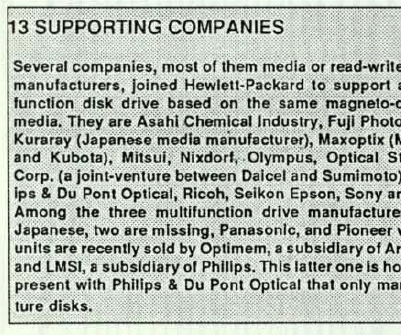History (1990): HP Tries to Lay Down New Optical Standard
Single disk for two functions
By Jean Jacques Maleval | December 23, 2019 at 2:17 pmTo make things easier, Hewlett-Packard (Greesley, CO), along with 13 other well-known companies, is offering a new approach of dual function optical disk drives: one single magneto-optical media with special protections to prevent overwriting when it’s necessary.
Today, there are two different kinds of optical disks, (more frequently) magneto-optical ones writable just like magnetic disks, and WORM ones that can only be written once for safety reasons.
Not so long ago, Panasonic, Pioneer and Ricoh launched dual function units that could indifferently read both types of media, but since their technologies were different so were their manufacturing.
Hewlett-Packard has just brought out the idea of using a same writable magneto-optical support for the two functions. To make it a WORM (HP says Thermo-Magnetic WORM or TMW), overwriting is prevented at the same place with by some precautions.
It would be comparable to diskettes when writing is impossible when the shutter is closed, but here the protection is at a higher level.
And even if they are based on the same magneto-optical technology in the ISO continuous composite format, the two 5.25-inch disks will be sold separately in two different color cartridges.
The WORM disk will have special identifier codes molded at the plant, others when it’s initialized, and a certification is planned every time writing is tried with a flag placed in the error correction code itself. If the WORM cartridge is inadvertently inserted in a rewritable unit, it will be ejected or an error message will be displayed.
In all this, HP is trying to make dual function units simpler by using only magneto-optical technology, with the same 325MB capacity per side disks.
Manufacturers of media will no longer have to fuss with two totally different supports and will save in scales, but they still have to prove it. There would no longer be double standardization. And eventual users could finally take advantage of more sources to buy disks and drives.
According to Alain Derche, in charge of peripheral products and systems at HP France, his company will announce a dual function unit using this and then afterwards a drive developed itself with the knowhow acquired with Optotech’s purchase.
But every rose has its thorn. Actual WORM supports offer a better guarantee for long-term data storage and are completely unwritable. Physically, when the laser makes a whole or a bubble, it’s permanent, unalterable, the whole will never be filled nor the bubble bursted.
And even if HP offers a great deal of protection guarantees for its magneto-optical disk, it still remains a support where the magnetic flux can be reversed.
In addition, a WORM disk prepared by HP won’t be compatible with current write-once disks. And what will happen with a new standard, one more, when the optical disk market has already endless standardization problems that actually are more a lack of true standards, and when another standard for 1GB magneto-optical disks is planned?
HP is a bit too late, but its new concept is interesting enough to seduce media and drive manufacturers.
The computer manufacturer operated the same way, with the same partner, Sony, when it tried to gain the 4mm DAT market with its DDS format.
No one can tell us yet if, just like for the Data-DAT, royalties will be claimed to endorse this new standard.
If HP succeeds, it will be an emergency to extend it to 3.5-inch magneto-optical disks since a drive is already available in USA, manufactured by MOST (Lake Forest, CA), distributed by Ocean Microsystems (Campbell, CA), both of them subsidiaries of Nakamichi of Japan, and recently put in Pinnacle Micro’s catalog (Irvine, CA) that sells them with 180MB disks supplied by Hoechst.
This doesn’t help current WORMs that find few buyers in the 5.25-inch format, in competition with erasable disks. They still have a small but safe offer in the 12-inch format for large applications where data is written once and its integrity has to be seriously guaranteed.
Although rumors arrived from USA that on some WORM disks, some sectors could be unreadable when writing occurred as the user turns off the blank check feature that ensures data is written to a blank sector.
IDC projected that 750 multi-function drives have been sold this year for evaluation, that 40,000 will be installed in 1992 and 120,000 in 1994. 35,000 WORM units were sold last year, and only 32,000 this one. By comparison, IDC considers that 30,000 erasable only units will take place in 1989 and 50,000 in 1990.

This article is an abstract of news published on the former paper version of Computer Data Storage Newsletter on issue ≠32, published on September 1990.














 Subscribe to our free daily newsletter
Subscribe to our free daily newsletter


